![]()
 |
|
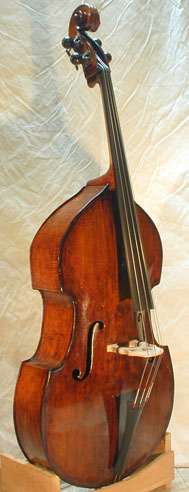 |
The bass is a very interesting small 3/4
used regularly in a major European Orchestra. It has a top made of four
pieces of spruce with gamba corners. The wood of the outer sides of the
top are of fine grain while the main sections are wide grain. The swell
back is made of unfigured maple and, unlike traditional carved backs which
are made with the edges in a single plane, this one rounds out at the
bottom end pin block, what is referred to as a cylinder back. The ribs
match the back except for the ones at the upper bout, which are early
Twentieth Century replacements made of well flamed maple. There are two
lines of purfling inlaid in the top and back made of a single width of
ebonized pear wood, except the top bouts, where rosewood was used when
the dimensions were reduced. There is a plugged half round at the end
pin end of the ribs, which would indicate that the ribs have been reduced
in width from their original size. The original three string clear maple
scroll has been grafted to a well flamed maple neck. It has side graft
over lay patches of clear maple probably installed when the bass was converted
to four strings. The individual tuning gears are made of iron with rosewood
pegs that have large decorative finials 1 ¾ inches round, about twice
what is normally seen, with mother of pearl buttons. They date from the
early Nineteenth Century. The fingerboard is ebony. The finish is the
original orange brown oil varnish that I recently restored. The instrument
is in excellent condition, having been completely restored by myself last
summer. The bass is 70 inches long over all. The body is 43 inches long,
20 ½ inches wide at the upper bout and 26 ½ inches at the lower. The ribs
are 6 inches at the top and vary until they reach their widest point at
the end pin, 8 inches, as described above. The mensure is 39 ¾ inches.
The instrument was made in Italy in the mid Eighteenth Century, maker
currently unknown. The unique design demonstrates the large amount of
experimentation the Italian makers of the time devoted to double basses.
|
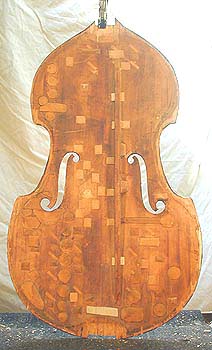 |
The top had collapsed 5/8 of an inch measured over the sound post. The picture on the right shows how it looked on the inside immediately after I removed it. This was to be a full restoration so I removed all of the patches with the exception of the many novel diagonal inlay cleats probably dating from the mid to late Nineteenth Century, as seen on the left. Not a repair I would recommend except occasional under bass bars. Since the original wood was long replaced I had to of course keep them in place. The sound post side f hole has the first cleat I installed. I used a plaster cast and two custom wood cauls for gluing the hand fit spruce overlays. I didn't press in the new wood but painstakingly fit the aged spruce to the original shape, as spruce exhibits a memory effect and will eventually return to its original shape unless the wood is a minor thickness compared to what it is glued to.
|
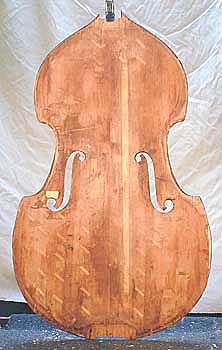 |
|
The top was
so worn away at the edges that a complete re-edging was necessary. Fortunately
this top has two lines of original purfling(usually only found in Italian
instruments) instead of the much more typical single line. (The purfling
itself consists of 3 separate strips of wood- dark, light, dark.) I was
able to accurately restore the edges to the original despite loss of the
outer line of purfling in many places by measuring from the inner purfling.
The picture to the right shows the top before it was re-glued to the ribs,
with the new bass bar, all the new patch work, re-edging and overlays.
|
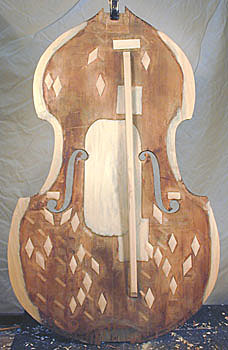 |
When the client
brought the bass to me for this long over due restoration there was some
concern the individual voice of the instrument might somehow be lost in
the process (with so much new wood added). In decades of professional
bass restoration I have never altered that "soul" of the instrument-
I am convinced that is determined by the overall shape and arching of
the top, the size and placement of the f holes and to a much lesser degree
the wood chosen. I consistently get the instrument to respond faster and
even in all registers, however. The player was delighted when the bass
was returned as a stronger sounding and easier to play version of itself.
Often one finds these old Italian gems with only 8 millimeters or less
of maximum top thickness- okay in the gut string era but unsuitable for
steel strings. The bass will always play as the though the sound post
is too tight, even when fit correctly- it doesn't have the strength to
spread out the pressure at the post. The addition of wood at the center
can strength the bass' voice without altering that voice- if done skillfully!
|
 |
The work on
this bass took only nine weeks but was the first thing on my bench just
about every day in that time.
|
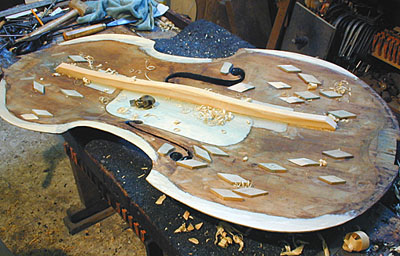 |
Copyright 2009, W. E. Merchant All rights reserved